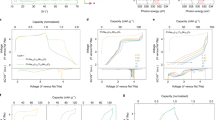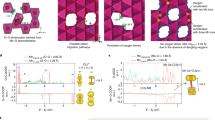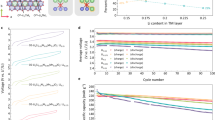Abstract
Despite the high energy density of lithium-rich layered-oxide electrodes, their real-world implementation in batteries is hindered by the substantial voltage decay on cycling. This voltage decay is widely accepted to mainly originate from progressive structural rearrangements involving irreversible transition-metal migration. As prevention of this spontaneous cation migration has proven difficult, a paradigm shift toward management of its reversibility is needed. Herein, we demonstrate that the reversibility of the cation migration of lithium-rich nickel manganese oxides can be remarkably improved by altering the oxygen stacking sequences in the layered structure and thereby dramatically reducing the voltage decay. The preeminent intra-cycle reversibility of the cation migration is experimentally visualized, and first-principles calculations reveal that an O2-type structure restricts the movements of transition metals within the Li layer, which effectively streamlines the returning migration path of the transition metals. Furthermore, we propose that the enhanced reversibility mitigates the asymmetry of the anionic redox in conventional lithium-rich electrodes, promoting the high-potential anionic reduction, thereby reducing the subsequent voltage hysteresis. Our findings demonstrate that regulating the reversibility of the cation migration is a practical strategy to reduce voltage decay and hysteresis in lithium-rich layered materials.
This is a preview of subscription content, access via your institution
Access options
Access Nature and 54 other Nature Portfolio journals
Get Nature+, our best-value online-access subscription
$29.99 / 30 days
cancel any time
Subscribe to this journal
Receive 12 print issues and online access
$259.00 per year
only $21.58 per issue
Buy this article
- Purchase on Springer Link
- Instant access to full article PDF
Prices may be subject to local taxes which are calculated during checkout





Similar content being viewed by others
Data availability
All relevant data within the article are available from the corresponding author on reasonable request. Source data for Figs. 2, 4 and 5 are provided with the paper.
References
Larcher, D. & Tarascon, J. M. Towards greener and more sustainable batteries for electrical energy storage. Nat. Chem. 7, 19–29 (2014).
Li, W., Song, B. & Manthiram, A. High-voltage positive electrode materials for lithium-ion batteries. Chem. Soc. Rev. 46, 3006–3059 (2017).
Hong, J., Gwon, H., Jung, S.-K., Ku, K. & Kang, K. Review—lithium-excess layered cathodes for lithium rechargeable batteries. J. Electrochem. Soc. 162, A2447–A2467 (2015).
Assat, G. & Tarascon, J.-M. Fundamental understanding and practical challenges of anionic redox activity in Li-ion batteries. Nat. Energy 3, 373–386 (2018).
Bettge, M. et al. Voltage fade of layered oxides: its measurement and impact on energy density. J. Electrochem. Soc. 160, A2046–A2055 (2013).
Sathiya, M. et al. Origin of voltage decay in high-capacity layered oxide electrodes. Nat. Mater. 14, 230–238 (2014).
Ku, K. et al. Suppression of voltage decay through manganese deactivation and nickel redox buffering in high-energy layered lithium-rich electrodes. Adv. Energy Mater. 8, 1800606 (2018).
Zheng, J. et al. Li- and Mn-rich cathode materials: challenges to commercialization. Adv. Energy Mater. 7, 1601284 (2017).
Mohanty, D. et al. Unraveling the voltage-fade mechanism in high-energy-density lithium-ion batteries: origin of the tetrahedral cations for spinel conversion. Chem. Mater. 26, 6272–6280 (2014).
Gallagher, K. G. et al. Correlating hysteresis and voltage fade in lithium- and manganese-rich layered transition-metal oxide electrodes. Electrochem. Commun. 33, 96–98 (2013).
Kleiner, K. et al. Origin of high capacity and poor cycling stability of Li-rich layered oxides: a long-duration in situ synchrotron powder diffraction study. Chem. Mater. 30, 3656–3667 (2018).
Gu, M. et al. Formation of the spinel phase in the layered composite cathode used in Li-ion batteries. ACS Nano 7, 760–767 (2013).
Hong, J. et al. Structural evolution of layered Li1.2Ni0.2Mn0.6O2 upon electrochemical cycling in a Li rechargeable battery. J. Mater. Chem. 20, 10179–10186 (2010).
Zheng, J. et al. Structural and chemical evolution of Li- and Mn-rich layered cathode material. Chem. Mater. 27, 1381–1390 (2015).
Mohanty, D. et al. Correlating cation ordering and voltage fade in a lithium–manganese-rich lithium-ion battery cathode oxide: a joint magnetic susceptibility and TEM study. Phys. Chem. Chem. Phys. 15, 19496–19509 (2013).
Wu, Y. et al. Probing the initiation of voltage decay in Li-rich layered cathode materials at the atomic scale. J. Mater. Chem. A 3, 5385–5391 (2015).
Rinaldo, S. G. et al. Physical theory of voltage fade in lithium- and manganese-rich transition metal oxides. J. Electrochem. Soc. 162, A897–A904 (2015).
Lee, E. & Persson, K. A. Structural and chemical evolution of the layered Li-excess LixMnO3 as a function of Li content from first-principles calculations. Adv. Energy Mater. 4, 1400498 (2014).
Kim, S. et al. Material design of high-capacity Li-rich layered-oxide electrodes: Li2MnO3 and beyond. Energ. Environ. Sci. 10, 2201–2211 (2017).
Lim, J.-M. et al. The origins and mechanism of phase transformation in bulk Li2MnO3: first-principles calculations and experimental studies. J. Mater. Chem. A 3, 7066–7076 (2015).
Li, Q. et al. K+-doped Li1.2Mn0.54Co0.13Ni0.13O2: a novel cathode material with an enhanced cycling stability for lithium-ion batteries. ACS Appl. Mater. Interfaces 6, 10330–10341 (2014).
Nayak, P. K., Grinblat, J., Levi, M. & Aurbach, D. Understanding the effect of lithium bis(oxalato) borate (LiBOB) on the structural and electrochemical aging of Li and Mn rich high capacity Li1.2Ni0.16Mn0.56Co0.08O2 cathodes. J. Electrochem. Soc. 162, A596–A602 (2015).
Shi, J.-L. et al. Mitigating voltage decay of Li-rich cathode material via increasing Ni content for lithium-ion batteries. ACS Appl. Mater. Interfaces 8, 20138–20146 (2016).
Reed, J. & Ceder, G. Role of electronic structure in the susceptibility of metastable transition-metal oxide structures to transformation. Chem. Rev. 104, 4513–4534 (2004).
Du, K. et al. Exploring reversible oxidation of oxygen in a manganese oxide. Energ. Environ. Sci. 9, 2575–2577 (2016).
Rong, X. et al. Structure-induced reversible anionic redox activity in Na layered oxide cathode. Joule 2, 125–140 (2018).
Maitra, U. et al. Oxygen redox chemistry without excess alkali-metal ions in Na2/3[Mg0.28Mn0.72]O2. Nat. Chem. 10, 288–295 (2018).
Delmas, C., Braconnier, J.-J., Fouassier, C. & Hagenmuller, P. Electrochemical intercalation of sodium in NaxCoO2 bronzes. Solid State Ion. 3–4, 165–169 (1981).
Paulsen, J. M., Thomas, C. L. & Dahn, J. R. Layered Li‐Mn‐oxide with the O2 structure: a cathode material for Li‐ion cells which does not convert to spinel. J. Electrochem. Soc. 146, 3560–3565 (1999).
Yabuuchi, N. et al. New O2/P2-type Li-excess layered manganese oxides as promising multi-functional electrode materials for rechargeable Li/Na batteries. Adv. Energy Mater. 4, 1301453 (2014).
de Boisse, B. M., Jang, J., Okubo, M. & Yamada, A. Cobalt-free O2-type lithium-rich layered oxides. J. Electrochem. Soc. 165, A3630–A3633 (2018).
Assat, G. et al. Fundamental interplay between anionic/cationic redox governing the kinetics and thermodynamics of lithium-rich cathodes. Nat. Commun. 8, 2219 (2017).
Gent, W. E. et al. Coupling between oxygen redox and cation migration explains unusual electrochemistry in lithium-rich layered oxides. Nat. Commun. 8, 2091 (2017).
Hong, J. et al. Metal–oxygen decoordination stabilizes anion redox in Li-rich oxides. Nat. Mater. 18, 256–265 (2019).
Lim, J. et al. Origin and hysteresis of lithium compositional spatiodynamics within battery primary particles. Science 353, 566–571 (2016).
Li, X. et al. Direct visualization of the reversible O2−/O− redox process in Li-rich cathode materials. Adv. Mater. 30, 1705197 (2018).
Luo, K. et al. Anion redox chemistry in the cobalt free 3d transition metal oxide intercalation electrode Li[Li0.2Ni0.2Mn0.6]O2. J. Am. Chem. Soc. 138, 11211–11218 (2016).
Gao, S. et al. The role of various components of transition metal layer on the properties of Li-rich cathode Li1.2[M0.4Mn0.4]O2 (M = Ni, Co, Ni1/2Mn1/2 and Fe). J. Electrochem. Soc. 164, A3824–A3831 (2017).
Myeong, S. et al. Understanding voltage decay in lithium-excess layered cathode materials through oxygen-centred structural arrangement. Nat. Commun. 9, 3285 (2018).
Paulsen, J. M., Thomas, C. L. & Dahn, J. R. O2 structure Li2/3[Ni1/3Mn2/3]O2: a new layered cathode material for rechargeable lithium batteries. I. Electrochemical properties. J. Electrochem. Soc. 147, 861–868 (2000).
Konishi, H. et al. Potential hysteresis between charge and discharge reactions in Li1.2Ni0.13Mn0.54Co0.13O2 for lithium ion batteries. Solid State Ion. 300, 120–127 (2017).
Konishi, H. et al. Origin of hysteresis between charge and discharge processes in lithium-rich layer-structured cathode material for lithium-ion battery. J. Power Sources 298, 144–149 (2015).
Hu, E. et al. Evolution of redox couples in Li- and Mn-rich cathode materials and mitigation of voltage fade by reducing oxygen release. Nat. Energy 3, 690–698 (2018).
Yang, W. & Devereaux, T. P. Anionic and cationic redox and interfaces in batteries: advances from soft X-ray absorption spectroscopy to resonant inelastic scattering. J. Power Sources 389, 188–197 (2018).
Dai, K. et al. High reversibility of lattice oxygen redox quantified by direct bulk probes of both anionic and cationic redox reactions. Joule 3, 518–541 (2019).
Assat, G., Iadecola, A., Delacourt, C., Dedryvère, R. & Tarascon, J.-M. Decoupling cationic–anionic redox processes in a model Li-rich cathode via operando X-ray absorption spectroscopy. Chem. Mater. 29, 9714–9724 (2017).
Manthiram, A., Knight, J. C., Myung, S.-T., Oh, S.-M. & Sun, Y.-K. Nickel-rich and lithium-rich layered oxide cathodes: progress and perspectives. Adv. Energy Mater. 6, 1501010 (2016).
Schipper, F. et al. Stabilizing nickel-rich layered cathode materials by a high-charge cation doping strategy: zirconium-doped LiNi0.6Co0.2Mn0.2O2. J. Mater. Chem. A 4, 16073–16084 (2016).
Grimaud, A. et al. Activation of surface oxygen sites on an iridium-based model catalyst for the oxygen evolution reaction. Nat. Energy 2, 16189 (2016).
Domanski, K. et al. Migration of cations induces reversible performance losses over day/night cycling in perovskite solar cells. Energ. Environ. Sci. 10, 604–613 (2017).
Kresse, G. & Furthmüller, J. Efficient iterative schemes for ab initio total-energy calculations using a plane-wave basis set. Phys. Rev. B 54, 11169–11186 (1996).
Dudarev, S. L., Botton, G. A., Savrasov, S. Y., Humphreys, C. J. & Sutton, A. P. Electron-energy-loss spectra and the structural stability of nickel oxide: an LSDA + U study. Phys. Rev. B 57, 1505–1509 (1998).
Seo, D.-H. et al. The structural and chemical origin of the oxygen redox activity in layered and cation-disordered Li-excess cathode materials. Nat. Chem. 8, 692–697 (2016).
Jain, A. et al. A high-throughput infrastructure for density functional theory calculations. Comput. Mater. Sci. 50, 2295–2310 (2011).
Qiao, R. et al. High-efficiency in situ resonant inelastic X-ray scattering (iRIXS) endstation at the Advanced Light Source. Rev. Sci. Instrum. 88, 033106 (2017).
Acknowledgements
This work was supported by Project Code (grant no. IBS-R006-A2) and the research programme of LG Chem. This research was supported by the National Research Foundation of Korea (NRF) grant funded by the Korea government (MSIP) (no. 2018R1A2A1A05079249), and Creative Materials Discovery Program through the National Research Foundation of Korea (NRF) funded by the Ministry of Science, ICT and Future Planning (NRF-2017M3D1A1039553).
Author information
Authors and Affiliations
Contributions
D.E., B.K. and K.K. designed the project. D.E. carried out the synthesis, structural characterization and electrochemical test and performed synchrotron-based measurements such as XRD, XANES and STXM. B.K. conducted the DFT calculations and analysed the experimental results. S.J.K. performed the HR-TEM measurement and interpreted all TEM data with simulations. H.P. and S.-P.C. conducted the Raman spectroscopy and Cs-STEM analysis, respectively. G.Y. provided the fundamental idea for the DFT calculations. M.H.L. and O.T. acquired the ex situ XRD and scanning electron microscopy data, respectively. S.-K.J. provided constructive advice for the experimental design. J.W. and W.Y. measured and processed the mRIXS data. W.M.S., K.K., S.K.P. and I.H. offered valuable comments for this project. D.E., B.K. and K.K. wrote the manuscript, and K.K supervised all aspects of the research.
Corresponding author
Ethics declarations
Competing interests
The authors declare no competing interests.
Additional information
Publisher’s note Springer Nature remains neutral with regard to jurisdictional claims in published maps and institutional affiliations.
Supplementary information
Supplementary Information
Supplementary Discussions 1–4, Figures 1–14, Tables 1–6, references 1–24
Rights and permissions
About this article
Cite this article
Eum, D., Kim, B., Kim, S.J. et al. Voltage decay and redox asymmetry mitigation by reversible cation migration in lithium-rich layered oxide electrodes. Nat. Mater. 19, 419–427 (2020). https://doi.org/10.1038/s41563-019-0572-4
Received:
Accepted:
Published:
Issue Date:
DOI: https://doi.org/10.1038/s41563-019-0572-4
This article is cited by
-
Sustainable layered cathode with suppressed phase transition for long-life sodium-ion batteries
Nature Sustainability (2024)
-
Fast-charge high-voltage layered cathodes for sodium-ion batteries
Nature Sustainability (2024)
-
Trapped O2 and the origin of voltage fade in layered Li-rich cathodes
Nature Materials (2024)
-
Structurally robust lithium-rich layered oxides for high-energy and long-lasting cathodes
Nature Communications (2024)
-
Highly structural stability from small-sized Li2MnO3-like domains in Co-free Li-rich layered oxide cathodes
Journal of Solid State Electrochemistry (2024)



